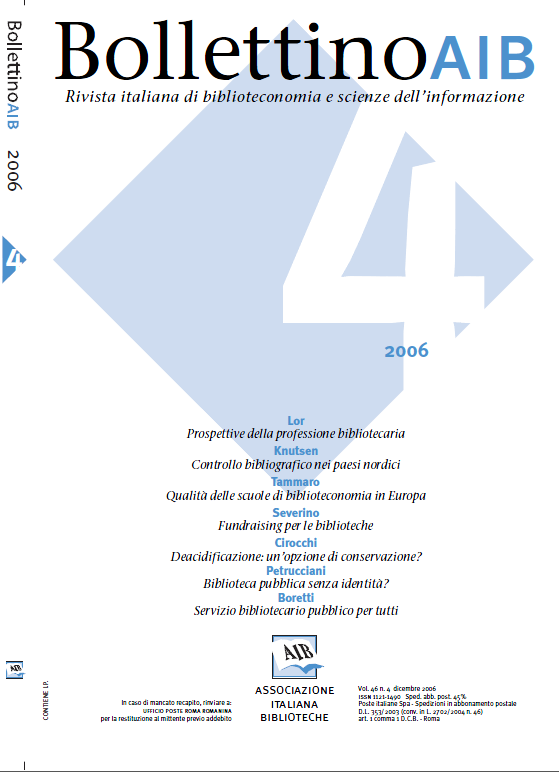Deacidification: a method of preservation?
Main Article Content
Abstract
One of the major preservation problems in modern libraries is the accelerated rate of decay of modern paper due to its exceeding acidity. The problem of the acid decomposition of paper concerns the majority of library and archival collections of 19th and of the first half of 20th century. The phenomenon was brought about with the beginning of industrial paper production and is to be ascribed to the components and techniques introduced from the middle of 19th century, but also air pollutants and unsuitable storage conditions can greatly affect the paper decay rate.The acidic paper problem was already known at the end of 19th century, but has been studied in its different aspects only from the late fifties on. About 70% of library and archival materials in Italy is exceedingly acidic. Besides it, an high percentage of library stocks is heavily damaged and no more susceptible of any deacidification or conservation treatment. Some institutions choose not to treat the damaged originals and to substitute them with a microfilm or digital copy. Obviously these measures cannot be applied to all the endangered materials. The technique called mass deacidification, for bulk treatment of books and archival materials without disbinding, can offer a chance to extend the suitable life of the originals.
Normally, after the pre-drying of the books, they are impregnated with an alkaline agent which neutralises the acids in the paper, and an alkaline buffer is inserted, so that to protect it against any further formation of acids.
There are nowadays several commercial methods for the mass deacidification of library and archival materials. Several experiences have been accomplished, and the results of them could form the basis for the evaluation of the opportunity of adopting a mass deacidification program. Nevertheless among the curators and conservators in charge of preservation management the debate is still open. The outlined disadvantages refer to some damages to materials, incomplete standardization on quality control tests, complexity of equipments and high costs. The amount of this factors led our country to lack a shared program of intervention. The author intends to introduce the experience of some countries which adopted national programs of mass deacidification or a limited and experimental approach in order to evaluate the different methods of intervention.
Normally, after the pre-drying of the books, they are impregnated with an alkaline agent which neutralises the acids in the paper, and an alkaline buffer is inserted, so that to protect it against any further formation of acids.
There are nowadays several commercial methods for the mass deacidification of library and archival materials. Several experiences have been accomplished, and the results of them could form the basis for the evaluation of the opportunity of adopting a mass deacidification program. Nevertheless among the curators and conservators in charge of preservation management the debate is still open. The outlined disadvantages refer to some damages to materials, incomplete standardization on quality control tests, complexity of equipments and high costs. The amount of this factors led our country to lack a shared program of intervention. The author intends to introduce the experience of some countries which adopted national programs of mass deacidification or a limited and experimental approach in order to evaluate the different methods of intervention.
Article Details
Section
Articles

This work is licensed under a Creative Commons Attribution-ShareAlike 4.0 International License.
